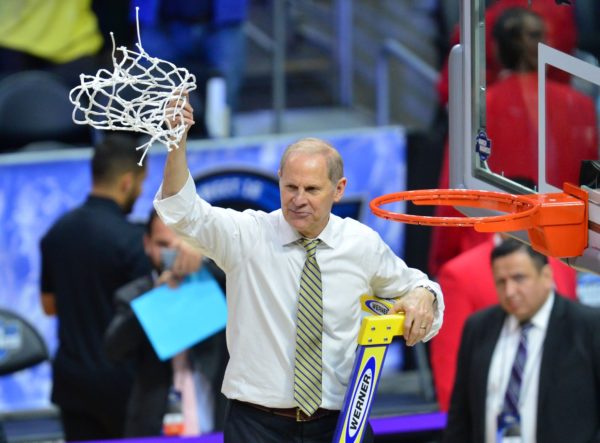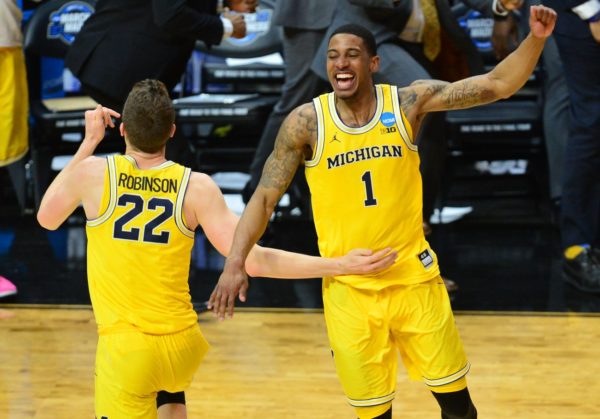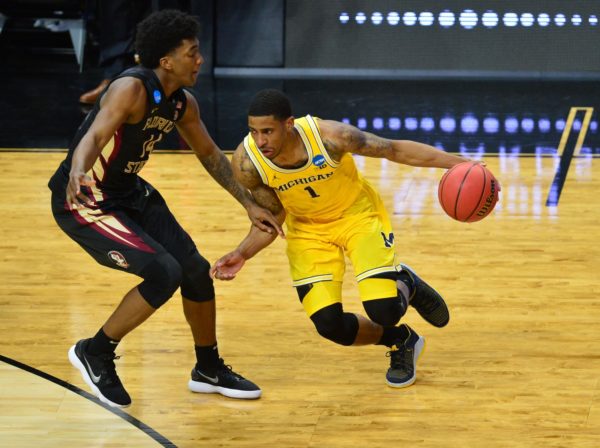Final Four Fact Sheet: Michigan Wolverines
Posted by Andrew Murawa on March 29th, 2018Now that the Final Four is set, our writers have put together a fact sheet on each of the four teams still remaining. Next, #3 Michigan, from the West Region.
How Michigan Got Here
West Region Champions. It’s been something of a mixed bag for the Wolverines in the NCAA Tournament to date. Their Sweet Sixteen win over Texas A&M was a sight to behold, a truly impressive performance that balanced explosive and beautiful offense with tight, frustrating defense. But wrapped around that performance have been three other wins highlighted mostly by their defense, with more misses than makes on the offensive end. But really, Michigan’s run to the Final Four began following an ugly 61-52 loss at Northwestern on February 6. Since that night, the Wolverines have reeled off 14 straight victories, including a romp through the Big Ten Tournament in Madison Square Garden. Their run through this tournament began with a tough win over Montana in which they held the Grizzlies to just two points in the first 10 minutes of the second half to break open a tight contest. In the Round of 32, their goose was more or less cooked, down 63-61 to Houston with just 3.6 seconds remaining — at which point they had a 3.4 percent chance of winning the game. But a buzzer-beating miracle by freshman Jordan Poole gave them the single extra point they needed to advance to the Sweet Sixteen. After doing a number to the Aggies in the regional semifinal, they withstood a gritty performance from Florida State last Saturday to advance to the program’s eighth Final Four in its history.
The Coach
John Beilein. John Beilein graduated from Wheeling College in 1975. Since then, he has never spent a basketball season as anything other than a head coach — he’s never been an assistant, nor has he taken a year away from the game. He worked his way through Newfane High School to Erie Community College to Division III Nazareth College to Divison II Le Moyne before finally getting a crack at a Division I job in 1992 with Canisius. He spent five years there, winning a regular season and tournament title to earn a crack at the Richmond job. In eastern Virginia, he again won a regular season and tournament title once each in five years, earning another upgrade to the job at West Virginia. He again spent five seasons there, making the NCAA Tournament twice including two runs to the Sweet Sixteen and an excruciating Elite Eight loss in overtime to Louisville in 2005. In 2007, Michigan hired Beilein to replace Tommy Amaker, and since then the well-traveled head coach has won two Big Ten regular season titles, consecutive Big Ten tournament titles, logged eight NCAA Tournament appearances in 11 years, advanced to four Sweet Sixteens and is now attending his second Final Four as a participant on the floor. By any measure, Beilein is considered one of the best coaches in all of college basketball.
Style
Beilein’s history at the Division I level has always been based around scoring. Since the beginning of the KenPom era in his final season at Richmond, his defensive efficiency has ranked higher than his offensive efficiency only five times. And his style has typically been associated with high utilization of the three-point shot. Only once in his 11 years at Michigan have the Wolverines attempted fewer than 40 percent of their field goals from three-point range, and this year is no exception. But, while this Michigan team attempts 43.1 percent of its shots from deep, they’re not quite as effective as some of Beilein’s other groups at just 36.1 percent. As always, however, Beilein is capable of adjusting. Over the past two seasons, Michigan has ranked among the top 10 teams nationally in taking away their opponents’ threes, holding them to fewer than 30 percent of their shots from distance. This year, under the assistance of defensive-minded assistant coach Luke Yaklich, the Wolverines have ramped up their defensive pressure, limiting opponents to a 47.6% eFG (35th in the nation) while also placing a priority on cleaning the defensive glass (24.7% offensive rebounding rate, 31st in the nation). While Michigan still runs many of the same offensive sets you’ve seen throughout Beilein’s career in Ann Arbor, it is an improved defense that sets this squad apart and gives it some necessary breathing room on nights that the shots aren’t falling.
Strengths
- Perimeter Defense. We’ve spent plenty of time on Michigan’s defensive prowess above, but what makes them so great in that area specifically is their length and commitment to non-stop harassment on the perimeter. Led by sophomore Zavier Simpson and his tendency to get under opposing ball-handlers’ skin immediately, the Wolverines don’t make anything easy. Long wings Charles Matthews and Muhammad-Ali Abdur-Rahkman are also excellent no-nonsense defenders backed up with size in the middle in the form of Moritz Wagner and underrated post defender Duncan Robinson. And while there may not be very much depth on this squad, don’t think you’re going to weaken the Wolverines by getting them into foul trouble. While them are aggressive defensively, only Wagner has any real history of being foul-prone.
- Offensive Balance. There probably isn’t one elite offensive player on this squad — although Wagner is surprisingly athletic and skilled for a big man, and Matthews may be on the brink of developing into a big thing — but everyone is very good. Simpson and Abdur-Rahkman can be interchangeable in terms of ball-handling responsibilities, with Matthews and Robinson able to help out in a pinch against pressure. Everyone on the team even remotely in the rotation (save sophomore seven-footer Jon Teske) is a capable perimeter shooter. And while they may not look like the ’87 Lakers when they walk on the basketball court, this is not a team whose athleticism you should take lightly — if you don’t get back on defense, they will burn you on the fast break.
Weaknesses
- Free Throw Shooting. The charity stripe has been a bugaboo for the Wolverines all year long. They rank 326th nationally on the freebies, knocking in just 66.1 percent of their attempts this season. In particular, Simpson is a liability, making just 51.1 percent, an issue that arose down the stretch against Florida State in the Elite Eight when he hit just one of three. Matthews isn’t a whole lot better at 56.6 percent from the line, and only Robinson (90%) inspires tremendous confidence when he heads there.
- Magic Disappearing Offense. Take away the Sweet Sixteen blowout against Texas A&M and Michigan has put together some offensive duds in the tournament. In the three other games combined, they’ve averaged a substandard 93.8 points per 100 possessions. Much of that can be traced back to their shooting woes, going just 17-of-68 from three-point range, good for 25 percent. Someone has come to the rescue in each of those games, but Wagner and Abdur-Rahkman in particular have had bouts of extended struggles in this tournament. As Beilein notes, some of that occurred because defenses were paying particularly close attention to those players — and correspondingly allowing guys like Matthews and Robinson to step into the void — but the Wolverines might need to find more consistency among their key contributors if they hope to advance from here.
Go-To Scorer
Charles Matthews (13.0 PPG for the year, 16.5 PPG in the NCAA Tournament). Wagner may be the team’s leading scorer and the public face of the program, but Matthews is the more traditional go-to guy. Wagner usually relies on others to get him the ball in a position to go to work, but Matthews can do that for himself. While he’s proven capable of slumping (he went through a stretch in early February when he averaged fewer than 8.0 PPG over seven games), the Kentucky transfer has been the most consistent offensive force for the Wolverines since the calendar flipped into March.
X-Factor
Zavier Simpson (7.5 PPG, 3.7 APG, 1.3 SPG). For a guy with the ball in his hands almost constantly, the Michigan floor general almost never turns the ball over. He has turned the ball over more than three times in a game only once this season, good for a 17.4 percent turnover rate that is outstanding for a point guard. Defensively, his effort is constant, making the right decisions on screens, hounding opposing guards non-stop, and keeping his hands active enough to threaten to make a steal. His skill with the ball allows him to get into the lane whenever he likes, but he doesn’t force it very often, instead making sure to get his team settled and into focused offensive sets. His struggles from the line, however, will be a story in any game from here on out that is tight down the stretch.
Outlook
The Wolverines may be playing against a mirror on Saturday evening in San Antonio, as Loyola-Chicago is another team that has had more success than star power this season. The Ramblers are going to defend like crazy, share the ball in the half-court and display all the hallmarks of a well-coached and a bought-in group of players. But all things considered, the Wolverines should be able to out-dude the Ramblers, something that has probably been said of every Loyola opponent thus far. Factor in Beilein and you can probably expect Michigan to be playing for a title on Monday night. Given that they would be facing the survivor of what should be an absolute battle between Villanova and Kansas, you have to give the Wolverines at least a puncher’s chance to grab its first National Championship in 29 years next week.













































